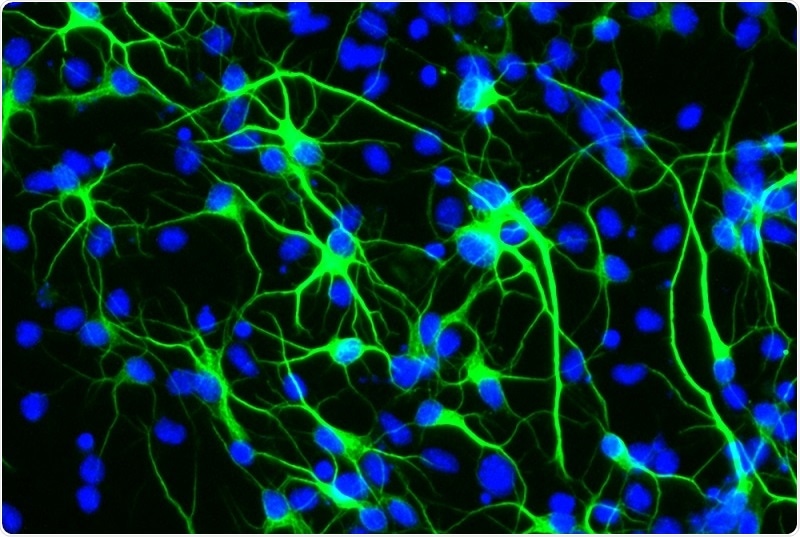According to a new study performed by researchers from Weill Cornell Medicine, a gene associated with an exceptionally long-life span in human beings guards the brain stem cells against the adverse effects of stress.

Antioxidant treatment boosts the birth of new neurons from stem cells by suppressing stress signaling. Image Credit: Image courtesy of the Paik lab.
Analyses of humans who lived more than a century have demonstrated that a number of humans share a strange version of a gene known as Forkhead Box Protein O3 (FOXO3). That finding led Dr. Jihye Paik, an associate professor of pathology and experimental medicine from Weill Cornell Medicine, and her collaborators to explore how this gene plays a key role in brain health at the time of aging.
Back in 2018, Dr. Paik and her research team demonstrated that mice lacking the FOXO3 gene in their brain are not able to deal with traumatic conditions in the brain, which contributes to the progressive death of brain cells.
Published recently in the Nature Communications journal, the team’s latest study showed that the FOXO3 gene maintains the brain’s capacity to regenerate by blocking stem cells from dividing until the environment supports the survival of the new cells.
Stem cells produce new brain cells, which are essential for learning and memory throughout our adult lives. If stem cells divide without control, they get depleted. The FOXO3 gene appears to do its job by stopping the stem cells from dividing until after the stress has passed.”
Dr. Jihye Paik, Associate Professor, Pathology and Laboratory Medicine, Weill Cornell Medicine
Dr. Paik is also a member of the Sandra and Edward Meyer Cancer Center at Weill Cornell Medicine.
Several difficulties, such as radiation, inflammation, or the absence of sufficient nutrition, may stress the brain. However, Dr. Paik and her collaborators specifically looked at what happens when the stem cells of the brain are subjected to oxidative stress, which happens when dangerous forms of oxygen accumulate in the body.
"We learned that the FOXO3 protein is directly modified by oxidative stress,” Dr. Paik added.
This alteration transfers the protein to the stem cell nucleus, where it switches on the stress response genes. The subsequent stress reaction caused the depletion of a nutrient known as s-adenosylmethionine (SAM). This nutrient is required to help the protein, dubbed lamin, create a protective envelope around the DNA in the stem cell nucleus.
Without SAM, lamin can't form this strong barrier and DNA starts leaking out.”
Dr. Jihye Paik, Associate Professor, Pathology and Laboratory Medicine, Weill Cornell Medicine
This DNA is considered as a virus infection by the cell, which thus activates an immune reaction known as type I interferon response. This makes the stem cells become dormant and stop creating new neurons.
This response is actually very good for the stem cells because the outside environment is not ideal for newly born neurons. If new cells were made in such stressful conditions they would be killed. It's better for stem cells to remain dormant and wait until the stress is gone to produce neurons.”
Dr Jihye Paik, Associate Professor, Pathology and Laboratory Medicine, Weill Cornell Medicine
The research work may help explain why some versions of the FOXO3 gene are associated with incredibly long and healthy lives. These versions may help individuals keep an excellent reserve of brain stem cells. It may even help understand why daily exercise, which improves the FOXO3 gene, helps maintain mental sharpness. However, Dr. Paik warned that it is still too early to determine if this latest data could be used to develop new treatments for brain disorders.
“It could be a double-edged sword. Over-activating FOXO3 could be very harmful. We don't want to keep this on all the time,” Dr. Paik concluded.
To further understand the mechanisms involved, Dr. Paik and her collaborators will continue to research how the FOXO3 gene is controlled and whether switching it on or off temporarily will be beneficial for health.
Source:
Journal reference:
Hwang, I., et al. (2021) Cellular stress signaling activates type-I IFN response through FOXO3-regulated lamin posttranslational modification. Nature Communications. doi.org/10.1038/s41467-020-20839-0.